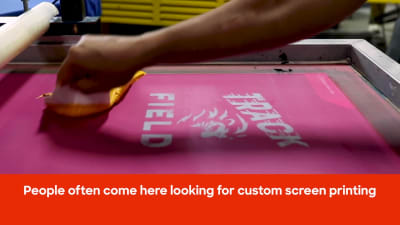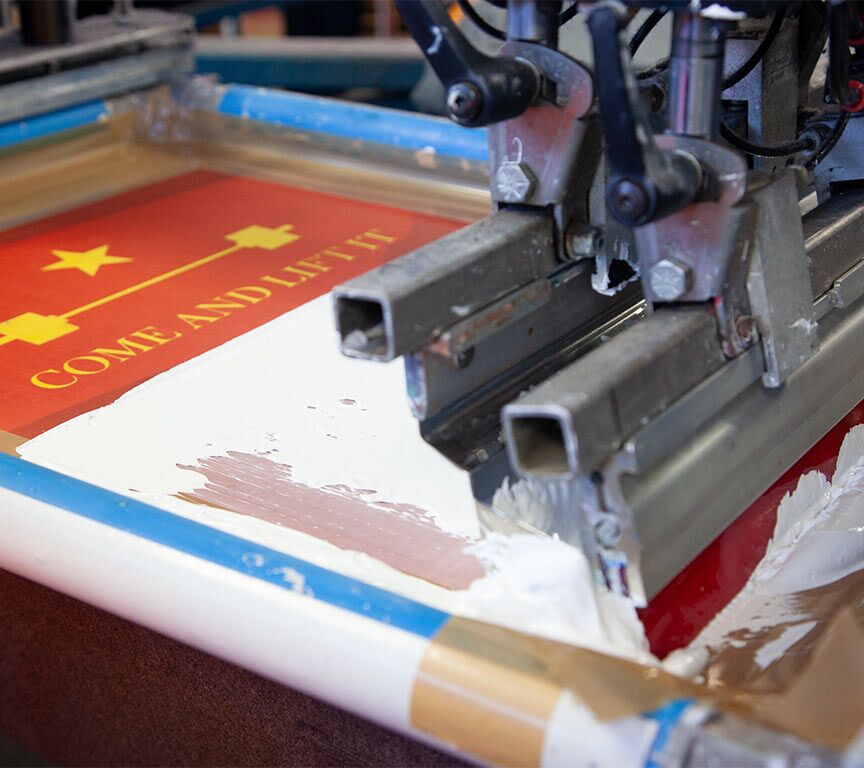Detailed Silk Screen Printing for Custom Art Apparel
Detailed Silk Screen Printing for Custom Art Apparel
Blog Article
Screen Printing Uncovered: Every Little Thing You Need to Understand About T-Shirt and Garment Printing Methods
If you have actually ever asked yourself just how those lively styles finish up on your favorite t-shirts, you remain in the appropriate location. Screen printing is a remarkable method that integrates art with strategy, using countless opportunities for creativity. Understanding the basics, from devices to ink options, can significantly impact your outcomes. Ready to discover the crucial elements that make screen publishing an art type? Allow's reveal the details that can raise your projects.
The Basics of Screen Printing: Just How It Functions
When you plunge right into display printing, you'll find it's both a scientific research and an art. At its core, screen printing involves producing a stencil, or display, that permits ink to pass via only in details locations.
Setting the screen over the material, then use a squeegee to push ink via the display onto the garment. Each action is essential, and mastering them will certainly boost your display printing abilities, changing basic garments into distinct, expressive pieces.
Kinds Of Display Printing Methods
When you comprehend the essentials of screen printing, it's time to explore the numerous strategies that can raise your layouts. One preferred approach is traditional screen printing, where ink is pushed through a stenciled screen. This technique is excellent for bold, lively colors. There's water-based ink printing, which uses a softer feeling and is environmentally friendly, yet it needs a various method to curing.
One more alternative is plastisol printing, understood for its sturdiness and vivid shades, making it a preferred for many brand names. Experiment with halftone printing to produce slope impacts and intricate layouts.
Important Devices for Screen Printing
To attain magnificent results in display printing, having the appropriate tools is basic. You'll require a sturdy screen printing frame, which holds the mesh that transfers your design onto the garment. Next off, spend in premium mops; these are necessary for applying ink uniformly across the screen.
Selecting the Right Inks and Products
When selecting inks and materials for screen printing, you require to think about the sort of ink that functions finest for your project. Consider material compatibility to assure your styles look great and last lengthy. Also, discover eco-friendly ink options to make your printing procedure more sustainable.
Types of Screen Inks
Choosing the ideal display ink is crucial for accomplishing dynamic, long lasting prints that meet your project's needs. There are numerous kinds of display inks to check out. Specialty inks, such as metal or glow-in-the-dark, can add special results to your layouts.

Fabric Compatibility Factors To Consider
Understanding textile compatibility is vital for accomplishing premium display prints, particularly considering that various materials respond distinctly to different inks. Always test your inks on sample textile to ensure they stick effectively and maintain shade integrity. Additionally, maintain in mind that material weight and structure can influence the final outcome, so picking the ideal ink and product combo is important for your job's success.
Eco-Friendly Ink Options
Environmentally friendly inks are becoming a preferred choice for screen printers who want to minimize their ecological influence while keeping high quality. When selecting inks, think about water-based inks, which are less hazardous and less complicated to tidy up contrasted to standard solvents. These inks bond well with materials, providing lively outcomes without poisonous chemicals. You could also explore eco-solvent inks that use fewer volatile natural compounds (VOCs), making them a much safer option for both your wellness and the world.
Additionally, search for inks made from sustainable resources, such as soy or vegetable-based options. By choosing the right inks and materials, you'll not only develop magnificent styles yet additionally contribute to an extra lasting printing procedure. Make the switch, and your prints will reflect your dedication to the setting!
Preparing Your Style for Screen Printing

Submit Style Requirements
To guarantee your layout looks sharp and vibrant on textile, you'll need to pay very close attention to submit format demands for display printing. Begin with vector documents like AI or EPS, as they can be scaled without losing top quality. If you utilize raster photos, go with high-resolution documents, such as TIFF or PNG, preferably at 300 DPI. Stay clear of utilizing JPEGs, as they can lose clearness when resized. Additionally, ensure your layout has a transparent background to stop undesirable white edges on your prints. Finally, keep color modes in mind; CMYK is standard for screen printing, so convert your RGB makes appropriately. By following these guidelines, you'll set your artwork up for a successful print.
Shade Splitting Up Techniques
Shade separation is a necessary step in preparing your layout for screen printing, and understanding it can substantially improve your print quality. You'll require to damage your style right into private shades, as each color calls for a separate display during printing. This accuracy not only assures exact shade representation however also streamlines the printing procedure.
Resolution and Dimension
Accomplishing the best outcomes in screen printing begins with assuring your style has the best resolution and size. Preferably, your art work must be at least 300 DPI (dots per inch) for sharp, clear prints. Your final item could look pixelated and unprofessional. if you utilize reduced resolution.
When it concerns dimension, consider the measurements of your print area. Design your art work to match the last print size, preferably developing it in the real dimensions you'll be printing. By doing this, you'll stay clear of any type of unexpected scaling issues.
Always inspect your layout in both vector and raster layouts. Vector graphics can be scaled without losing high quality, making them suitable for display printing. Preparing appropriately will assure your layout looks outstanding on every garment!
Step-by-Step Screen Printing Process
Screen printing is a vibrant procedure that permits you to create vibrant styles on numerous surfaces. To get begun, you'll require a display, emulsion, custom screen printing and your picked ink.
Put ink onto the display and use a squeegee to press the ink with the stencil onto the textile. Lift the display carefully and allow the print dry. You have actually effectively display published your style.
Tips for Successful Display Printing Projects
While you're diving into your display printing tasks, bear in mind that preparation is vital to success. Begin by gathering all your products-- inks, screens, squeegees, and garments. A clean work space assists prevent unwanted mistakes, so neat up before you start.
Next, validate your art work is high-resolution and effectively sized for your garment. Test your screen for correct exposure and clean it extensively to prevent smudges. When mixing your inks, follow the manufacturer's standards to accomplish the right uniformity.
Throughout printing, apply also pressure with your squeegee for consistent outcomes. Don't hurry; take your time to validate each print fulfills your criteria. After printing, allow your garments completely dry entirely prior to managing or packaging them.
Lastly, always maintain a sample of your benefit future reference. In this manner, you can examine your progression and enhance your techniques in time. Pleased printing!

Regularly Asked Questions
The length of time Does It Require To Establish a Screen Printing Work?
Establishing up a display printing task typically takes around 30 mins to an hour. You'll prepare the displays, mix inks, and change the press. The time varies based upon intricacy and experience, so stay organized!
Can I Publish on Various Fabric Types Making Use Of the Same Method?
Yes, you can print on different fabric kinds utilizing the same technique, yet you'll require to change your inks and settings. Some materials soak up ink in a different way, so trying out assurances the most effective results for every material.
What Are Typical Blunders to Prevent in Screen Printing?
When display printing, prevent usual errors like utilizing the incorrect ink, ignoring appropriate direct exposure times, or avoiding pre-press checks. Always check your configuration and preserve clean displays to guarantee top quality results each time.
How Can I Effectively Clean and Maintain My Screen Printing Equipment?
To appropriately clean and keep your screen printing tools, you ought to frequently wash displays with appropriate solvents, examine squeegees for wear, and assure all tools are saved completely dry and dust-free. Consistency protects against costly repairs and enhances efficiency.
Is Screen Printing Eco Pleasant Compared to Various Other Methods?
Display printing can be a lot more ecologically friendly than various other approaches, especially if you utilize water-based inks and eco-conscious products. By selecting lasting products and practices, you minimize waste and minimize your influence on the earth.
Display Printing Uncovered: Everything You Required to Know Concerning T-Shirt and Garment Printing Techniques
At its core, screen printing includes developing a pattern, or display, that permits ink to pass through only in particular locations. Placement the screen over the fabric, then utilize a squeegee to press ink through the display onto the garment. One popular method is standard display printing, where ink is pressed through a stenciled screen.When choosing inks and materials for screen printing, you require to take into account the kind of ink that works best for your project.
Report this page